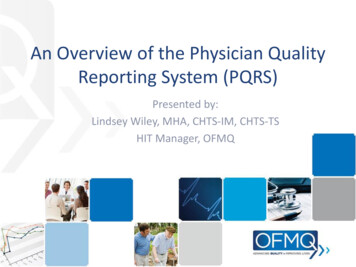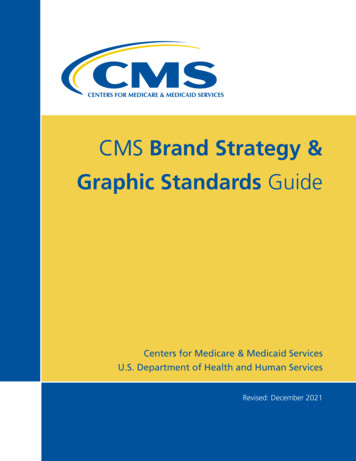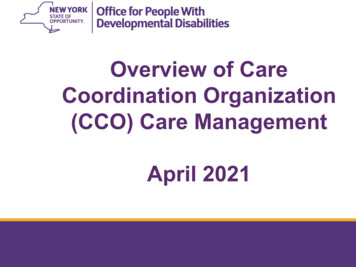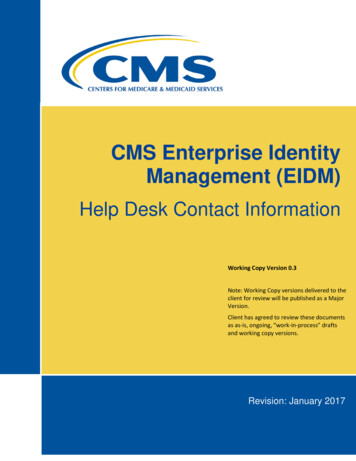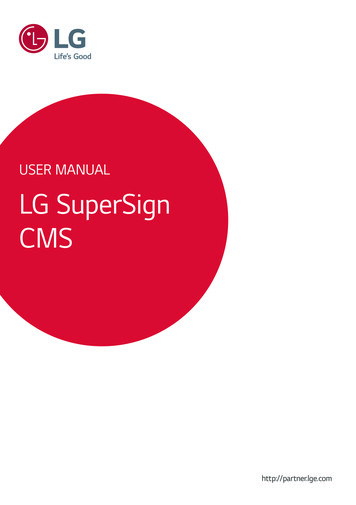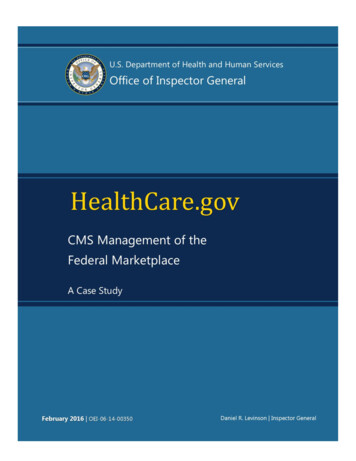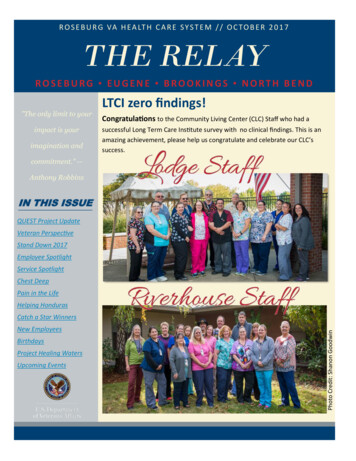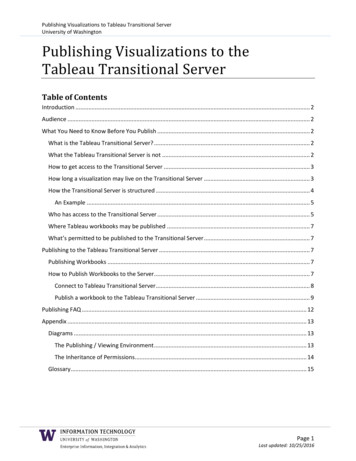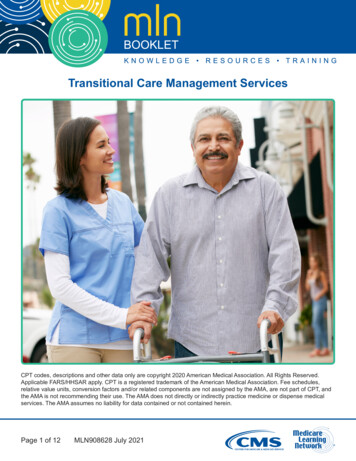
Transcription
Transitional Care Management ServicesCPT codes, descriptions and other data only are copyright 2020 American Medical Association. All Rights Reserved.Applicable FARS/HHSAR apply. CPT is a registered trademark of the American Medical Association. Fee schedules,relative value units, conversion factors and/or related components are not assigned by the AMA, are not part of CPT, andthe AMA is not recommending their use. The AMA does not directly or indirectly practice medicine or dispense medicalservices. The AMA assumes no liability for data contained or not contained herein.Page 1 of 12MLN908628 July 2021
Transitional Care Management ServicesMLN BookletTable of ContentsWhat’s Changed? . 3Introduction. 4TCM Services Requirements . 4Health Care Professionals Who May Provide TCM Services . 5Supervision . 5TCM Components . 5Billing TCM Services .11Billing TCM Services FAQs. 12Resources . 12Page 2 of 12MLN908628 July 2021
Transitional Care Management ServicesWhat’s Changed? Added codes health care professionals can bill concurrently with Transitional CareManagement services Added language about auxiliary personnel providing services under supervisionYou’ll find substantive content updates in dark red font.Page 3 of 12MLN908628 July 2021MLN Booklet
Transitional Care Management ServicesMLN BookletIntroductionThis booklet outlines transitional care services during the “30-day period,”which begins when a physician discharges the patient from an inpatient stayand continues for the next 29 days. Medicare may cover these services tohelp a patient transition back to a community setting after a stay at certainfacility types.This booklet focuses on covered services, location, who may provide services,supervision, billing services, documenting services, and service benefits.In this booklet,you refers tophysicians orhealth careprofessionalsprovidingTCM services.TCM Services RequirementsRequired patient TCM services include: Supporting the patient’s transition to the community setting Health care professionals who accept patient care at post-facility discharge without a service gap Health care professionals taking responsibility for patient’s care Moderate or high complexity medical decision making for patients who have medical orpsychosocial problemsThe 30-day TCM period begins on a patient’s inpatient discharge date and continues for the next 29 days.TCM services begin the day of discharge from 1 of these inpatient or partial hospitalization settings: Inpatient Acute Care Hospital Inpatient Psychiatric Hospital Long-Term Care Hospital Skilled Nursing Facility Inpatient Rehabilitation Facility Hospital outpatient observation or partial hospitalization Partial hospitalization at a Community Mental Health CenterAfter inpatient discharge, the patient must return to their community setting. These could include: Home Domiciliary Nursing home Assisted living facilityPage 4 of 12MLN908628 July 2021
Transitional Care Management ServicesMLN BookletHealth Care Professionals Who May Provide TCM ServicesThe following list of health care practitioners must provide the services associated with the TCM faceto-face visit and can supervise auxiliary personnel, which includes clinical staff: Physicians (any specialty) Non-Physician Practitioners (NPPs) legally authorized and qualified to provide the services in thestate where they practice: Certified Nurse-Midwives (CNMs) Clinical Nurse Specialists (CNSs) Nurse Practitioners (NPs) Physician Assistants (PAs)CNMs, CNSs, NPs, and PAs may provide non-face-to-face TCM services incident to services of aphysician and other CNMs, CNSs, NPs, and PAs.SupervisionThe TCM codes are care management codes. As care management codes, auxiliary personnel mayprovide the non-face-to-face services of TCM under the general supervision of the physician or NPPsubject to applicable state law, scope of practice, and the Medicare Physician Fee Schedule (PFS)“incident to” rules and regulations.CNMs, CNSs, NPs, and PAs may also provide the non-face-to-face services of TCM incident to theservices of a physician.TCM ComponentsWhen a patient is discharged from an approved inpatient setting, you must provide at least theseTCM components over the course of the 30-day service period:An Interactive ContactWithin 2 business days following the patient’s discharge, you must contact the patient or theircaregiver via phone, email, or face-to-face. You or your “clinical staff” (A person who works underthe supervision of a physician or other qualified health care professional and is allowed by law,regulation, and facility policy to perform or assist in the performance of a specialized professionalservice, but who doesn’t individually report that professional service) can address patient status andneeds beyond scheduling follow-up care. Get more information about interactive contacts in the CPTCodebook at the American Medical Association Store.Report the service if you make 2 or more unsuccessful separate attempts in a timely manner.Document your attempts in the medical record if you meet all other TCM criteria. Continue tryingPage 5 of 12MLN908628 July 2021
Transitional Care Management ServicesMLN Bookletto communicate with the patient until successful. If the face-to-face visit isn’t within the requiredtimeframe, you can’t bill TCM services (see the Face-to-Face Visit section).More resources are available to help you understand and identify disparities that may affect TCM: Building an Organizational Response to Health Disparities — Resources and concepts forimproving equity and responding to disparities. Concepts include data collection, data analysis,culture of equity, quality improvement, and interventions Guide to Reducing Disparities in Readmissions — An overview and case studies of key carecoordination and readmission issues and strategies for racially and ethnically diverseMedicare patientsCertain Non-Face-to-Face ServicesYou must provide patient non-face-to-face services, unless you determine they aren’t medicallyindicated or needed. Clinical staff under your direction may provide certain non-face-to-face services.Services Provided by Physicians or NPPsPhysicians or NPPs may provide these non-face-to-face services: Review discharge information (for example, discharge summary or continuity-of-care documents) Review the patient’s need for, or follow-up on, pending diagnostic tests and treatments Interact with other health care professionals who may assume or reassume care of the patient’ssystem-specific problems Educate the patient, family, guardian, or caregiver Establish or re-establish referrals and arrange needed community resources Help schedule required community providers and services follow-upTCM Services Provided By Auxiliary Personnel Under Physician orNPP General SupervisionAuxiliary personnel may provide the following non-face-to-face TCM services under generalsupervision at any time during the 30-day TCM service period: Communicate with the patient Communicate with agencies and community service providers that the patient uses Educate the patient, family, guardian, or caregiver to support self-management, independentliving, and activities of daily living Assess and support treatment adherence including medication management Identify available community and health resources Help the patient and family access needed care and servicesPage 6 of 12MLN908628 July 2021
Transitional Care Management ServicesMLN BookletFace-to-Face VisitYou must provide 1 face-to-face visit within the timeframes described by these 2 CPT codes: CPT Code 99495 — Transitional Care Management services with the following required elements:Communication (direct contact, telephone, electronic) with the patient and/or caregiver within 2business days of discharge; Medical decision making of at least moderate complexity during theservice period; Face-to-face visit, within 14 calendar days of discharge CPT Code 99496 — Transitional Care Management services with the following required elements:Communication (direct contact, telephone, electronic) with the patient and/or caregiver within 2business days of discharge; Medical decision making of high complexity during the service period;Face-to-face visit, within 7 calendar days of dischargeYou shouldn’t report the TCM face-to-face visit separately.The 2021 Medicare Physician Fee Schedule Final Rule revised TCM billing requirements, allowingyou to bill additional codes concurrently with TCM codes. See Table 1 for details.Table 1. HCPCS Codes That Can be Billed ConcurrentlyHCPCS escriptorESRD related services with 4 or more face-to-face visits per month; for patients 2 years of ageESRD related services with 4 or more face-to-face visits per month; for patients2–11 yearsESRD related services with 2–3 face-to-face visits per month; for patients2–11 yearsESRD related services with 1 face-to-face visit per month; for patients 2–11 yearsESRD related services with 4 or more face-to-face visits per month; for patients12–19 yearsESRD related services with 2–3 face-to-face visits per month; for patients12–19 yearsESRD related services with 1 face-to-face service per month; for patients12–19 yearsEnd Stage Renal Disease (ESRD) related services monthly, for patients 20 yearsof age and older; with 4 or more face-to-face visits by a physician or otherqualified health care professional per monthESRD related services monthly with 2–3 face-to-face visits, for patients 20 yearsof age and older, by a physician or other qualified health care professionalper monthCPT only copyright 2020 American Medical Association. All rights reserved.Page 7 of 12MLN908628 July 2021
Transitional Care Management ServicesMLN BookletTable 1. HCPCS Codes That Can be Billed Concurrently (cont.)HCPCS 3792937939909199358DescriptorESRD related services monthly with 1 face-to-face visit for patients 20 years andolder, by a physician or other qualified health care professional per monthESRD related services for home dialysis per full month; for patients 2 years of ageESRD related services for home dialysis per full month; for patients 2–11 yearsESRD related services for home dialysis per full month; for patients 12–19 yearsESRD related services for home dialysis per full month; for patients 20 years ofage and olderESRD related services for home dialysis per full month; per day; for patients 2years of ageESRD related services for home dialysis per full month; per day; for patients2–11 yearsESRD related services for home dialysis per full month; per day; for patients12–19ESRD related services for dialysis less than a full month of service; per day; forpatient 20 years of age and olderPatient/caregiver training for initiation of home international normalized ratio(INR) monitoring under the direction of a physician or other qualified healthcare professional, face-to-face, including use and care of the INR monitor,obtaining blood sample, instructions for reporting home INR test results, anddocumentation of patient’s/caregiver’s ability to perform testing and report resultsAnticoagulant management for a patient taking warfarin; must include reviewand interpretation of a new home, office, or lab international normalized ratio(INR) test result, patient instructions, dosage adjustment (as needed) andscheduling of additional test(s) when performedCollection and interpretation of physiologic data (eg, ECG, blood pressure,glucose monitoring) digitally stored and/or transmitted by the patient and/orcaregiver to the physician or other qualified health care professional, qualified byeducation, training, licensure/regulation (when applicable) requiring a minimumof 30 minutes of time, each 30 daysProlonged Evaluation and Management (E/M) service before and/or after directpatient care; first hour, non-face-to-face time spent by a physician or otherqualified health care professional on a given date providing prolonged servicesCPT only copyright 2020 American Medical Association. All rights reserved.Page 8 of 12MLN908628 July 2021
Transitional Care Management ServicesMLN BookletTable 1. HCPCS Codes That Can be Billed Concurrently (cont.)HCPCS Code9935999487994899949099491DescriptorProlonged E/M service before and/or after direct patient care; each additional 30minutes (List separately in addition to code for prolonged service)Complex chronic care management services with the following requiredelements: multiple (two or more) chronic conditions expected to last at least 12months, or until the death of the patient, chronic conditions place the patientat significant risk of death, acute exacerbation/decompensation, or functionaldecline, comprehensive care plan established, implemented, revised, ormonitored, moderate or high complexity medical decision making; first 60minutes of clinical staff time directed by a physician or other qualified health careprofessional, per calendar monthComplex chronic care management services with the following requiredelements: multiple (two or more) chronic conditions expected to last at least12 months, or until the death of the patient, chronic conditions place thepatient at significant risk of death, acute exacerbation/decompensation,or functional decline, comprehensive care plan established, implemented,revised, or monitored, moderate or high complexity medical decision making;each additional 30 minutes of clinical staff time directed by a physician orother qualified health care professional, per calendar month (List separately inaddition to code for primary procedure)Chronic care management services with the following required elements:multiple (two or more) chronic conditions expected to last at least 12 months, oruntil the death of the patient, chronic conditions place the patient at significantrisk of death, acute exacerbation/decompensation, or functional decline,comprehensive care plan established, implemented, revised, or monitored; first20 minutes of clinical staff time directed by a physician or other qualified healthcare professional per calendar monthChronic care management services provided personally by a physician or otherqualified health care professional, at least 30 minutes of physician or otherqualified health care professional time, per calendar month, with the followingrequired elements: multiple (two or more) chronic conditions expected to lastat least 12 months, or until the death of the patient; chronic conditions placethe patient at significant risk of death, acute exacerbation/decompensation, orfunctional decline; comprehensive care plan established, implemented, revised,or monitoredCPT only copyright 2020 American Medical Association. All rights reserved.Page 9 of 12MLN908628 July 2021
Transitional Care Management ServicesMLN BookletTable 1. HCPCS Codes That Can be Billed Concurrently (cont.)HCPCS CodeG0181G0182G2058DescriptorPhysician supervision of a patient receiving medicare-covered services providedby a participating home health agency (patient not present) requiring complexand multidisciplinary care modalities involving regular physician developmentand/or revision of care plans, review of subsequent reports of patient status,review of laboratory and other studies, communication (including telephonecalls) with other health care professionals involved in the patient’s care,integration of new information into the medical treatment plan and/or adjustmentof medical therapy, within a calendar month, 30 minutes or morePhysician supervision of a patient under a medicare-covered hospice (patientnot present) requiring complex and multidisciplinary care modalities involvingregular physician development and/or revision of care plans, review ofsubsequent reports of patient status, review of laboratory and other studies,communication (including telephone calls) with other health care professionalsinvolved in the patient’s care, integration of new information into the medicaltreatment plan and/or adjustment of medical therapy, within a calendar month,30 minutes or moreChronic care management services, each additional 20 minutes of clinical stafftime directed by a physician or other qualified health care professional, percalendar monthTelehealth ServicesYou may provide CPT codes 99495 and 99496 via telehealth. Medicare pays for a limited numberof Part B services you provide an eligible patient via a telecommunications system. Using eligibletelehealth services substitutes for an in-person encounter. Find more information about eligibleservices in the Telehealth Services booklet.Medical Decision MakingMedical decision making refers to a complex diagnosis and selecting a management option byconsidering these factors: Number of possible diagnoses and management options Amount and complexity of medical records, diagnostic tests, and other information you must get,review, and analyze Risk of significant complications, morbidity, and mortality as well as comorbidities associated withthe patient’s problem(s), the diagnostic procedure(s), and the possible management optionsCPT only copyright 2020 American Medical Association. All rights reserved.Page 10 of 12MLN908628 July 2021
Transitional Care Management ServicesMLN BookletTable 2 shows the elements for each medical decision-making level. Your service must meet orexceed 2 of the 3 elements to qualify for a given type of medical decision making.Table 2. Elements for Each Medical Decision-Making LevelDecision TypeStraightforwardLow ComplexityModerate ComplexityHigh ComplexityDiagnoses &ManagementOptions PossibleMinimalLimitedMultipleExtensiveData Amount &ComplexityMinimal or ns,Morbidity, &Mortality RiskMinimalLowModerateHighFind more information about medical decision making on the Evaluation and Management: BillingCorrect Level of Service webpage.Medication Reconciliation & ManagementYou must provide medication reconciliation and management on or before the face-to-face visit date.Billing TCM ServicesThis list offers TCM services billing tips: Only 1 physician or NPP may report TCM services. Report services once per patient during the TCM period. The same health care professional may discharge the patient from the hospital, report hospital orobservation discharge services, and bill TCM services. The required face-to-face visit can’t takeplace on the same day you report discharge day management services. Report reasonable and necessary Evaluation and Management (E/M) services (except requiredface-to-face visit) to manage the patient’s clinical issues separately. You can’t bill TCM services and services within a post-operative global surgery period (Medicaredoesn’t pay TCM services if any of the 30-day TCM period falls within a global surgery period for aprocedure code billed by the same practitioner). At a minimum, document this information in the patient’s medical record: Patient discharge date Patient or caregiver first interactive contact date Face-to-face visit date Medical complexity decision making (moderate or high)CPT only copyright 2020 American Medical Association. All rights reserved.Page 11 of 12MLN908628 July 2021
Transitional Care Management ServicesMLN BookletBilling TCM Services FAQsFind more information on billing in the FAQs about Billing the PFS for TCM Services.Resources Evaluation & Management Visits Telehealth Services WebpageMedicare Learning Network Content Disclaimer, Product Disclaimer, and Department of Health & Human Services DisclosureThe Medicare Learning Network , MLN Connects , and MLN Matters are registered trademarks of the U.S. Departmentof Health & Human Services (HHS).Page 12 of 12MLN908628 July 2021
This booklet outlines transitional care services during the "30-day period," which begins when a physician discharges the patient from an inpatient stay and continues for the next 29 days. Medicare may cover these services to . help a patient transition back to a community setting after a stay at certain facility types.
